Jagriti Yatra: The Mother Of All Roller Coasters
Okay no, so it’s not an actual roller coaster.
Jagriti Yatra is a fifteen-day 8,000-kilometer train ride that lugs over 700 people around India with the ambition of igniting their entrepreneurship spirit. The train goes from place to place, visiting local social entrepreneurs that have already dented the landscape in largely positive ways.
I couldn’t have found a more perfect set up for an introductory crash course on the impact space in India.
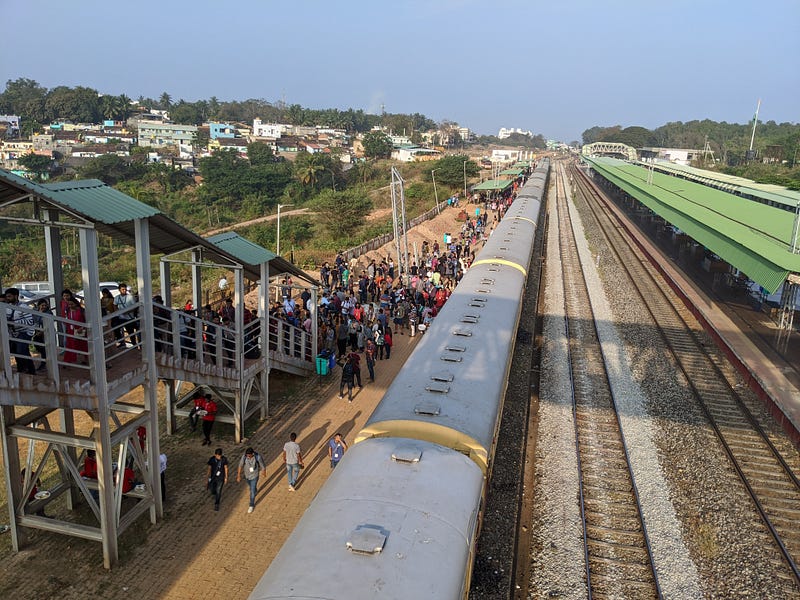
This long-tailed journey is by no means luxurious. It’s anything but. You’re squeezed into bogies that are non-AC (a traditional Indian 3-tier if you know what that is), sleeping somewhere on a triple bunk bed that averages six feet by three feet, using squat toilets and showering with buckets, all the while hoping that the water doesn’t run out as the train tries to cater to the hygiene of 700 people.
But that’s the point. It’s not supposed to be comfortable. It’s supposed to be real. Add that reality check to a supremely diverse group of Indian youth, and what emerges is a roller coaster of conversations, emotions and experiences.
So yes, Jagriti Yatra is somewhat of a roller coaster. And all-in-all, like most roller coasters, this roller coaster was a ton of fun.
Induction
For our Yatra, there were about 450 participants and about 250 support staff who were living on the train (think everyone — from the CEO to the pantry staff to the cleaners). The participants or the “Yatris” were divided into around 65 facilitators — the older, supposedly wiser crew — and about 400 younger Yatris who averaged at about 24 years of age. What united us all though was a hunger to learn more about entrepreneurship and nation-building.
Since I was slightly older and supposedly wiser, I became a “faci” — short for facilitator (but way too close to fascist). Each “faci” was assigned a cohort of six younger Yatris who we had to guide or facilitate while explicitly avoiding any form of paternalism. So far, spot on and not very fascist.
The induction process was a well-organized ball of chaos. There was flag-waving, dancing, key-note speakers, registration forms and quick health check-ups (really quick). We were also introduced to a ritual of sorts — a song and dance that everyone was supposed to partake in. And the kicker — we would be doing this ritual at every stop, whenever we could and with as much energy as possible. When I sent over a video of this to my friends, the responses averaged out to: what cult have you joined?
All cults are not bad though, right? As long as they weren’t spiking our drinks with anything.
The First Stop
Our first stop was Hubli in Karnataka. It was a day and half worth of low-priority train time from Mumbai. And since it was our first stop, I was itching to get out and see.
Each stop had a “role model” who is essentially a seasoned entrepreneur turning the tide, one wave at a time. They talked to us about the waves they had conquered, hoping to seed ideas and inspiration, especially among the youth.
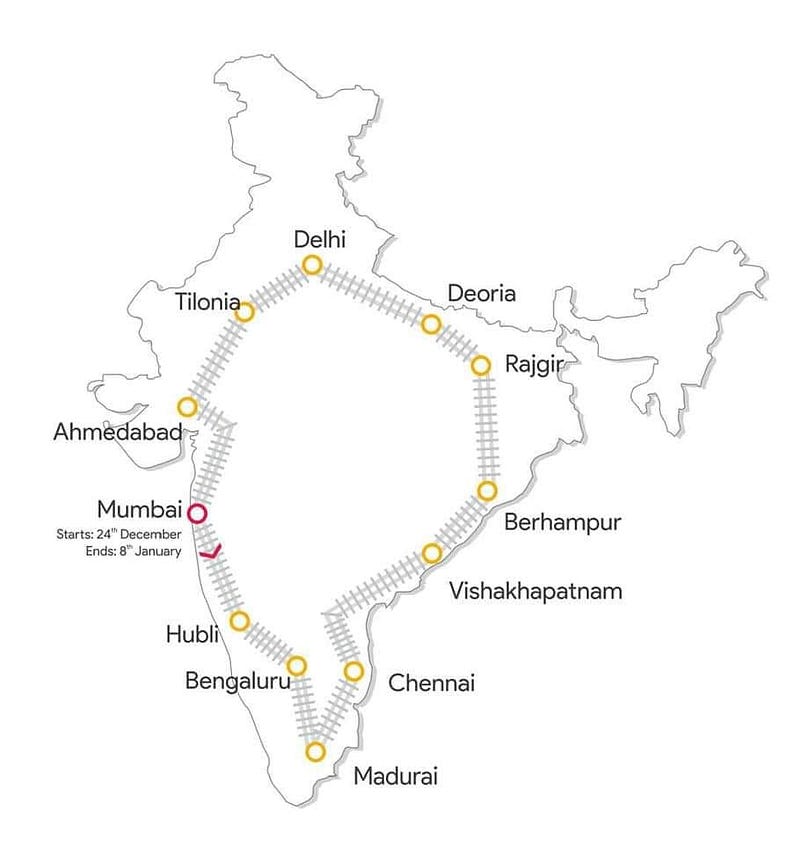
In Hubli we visited a semi-alternative school run in a village by some kind foreigners. It is a free school run on donations that provides schooling to the most in need in the village where it is. They use music, dance and art to mine minds while floating in a campus supported mainly by solar energy and trees. It was peaceful there — the kind of peace that is only extenuated by the innocent rapture of a child.
But what I quickly started to realize was that this Yatra, this journey, was less about the stops and the ‘role models’ along the way. It was more about the people living on the train.
Conversations
It’s quite the logistical nightmare to transport 700 people across 12 different places in India in 15 days on a train whilst also feeding the hive four times a day. Also, since our train was a private train, it was classified as low priority. Which meant it moved along at the fancy of the Indian Railways. Which essentially meant a lot of ambiguity. Let’s just say that uncertainty and logistics don’t go well together.
Once we arrived at a stop, we were loaded into ten buses and transported to the village or the social enterprise we were supposed to be enlightened by. Since this happened every day, it’s safe to say we spent more time on the train and in buses than at a stop. This meant that there was time for conversations with people living on the train. A lot of time. Luckily, that just happened to be the best part.
For instance, my cohort had six guys from six different states — a Kashmiri who runs a school there, a Maharashtrian with an MA in English Literature, a PhD student from Odisha, a Bengali who studied at the Aurobindo School in Pondicherry, a Hyderabadi ethical hacker and a budding entrepreneur from Delhi. Not only was there diversity, but there was also a ritualistic energy that brought us together.
And the sheer proximity of living together quickly transformed the formal exchanges into informal fraternity. We tried to have check-ins and check-outs every day as a cohort. While we weren’t always successful, we talked about everything — our goals, our feelings, our opinions. And I learnt more from them than they can imagine.
It was a safe space. Safe enough for the Kashmiri to share what he wouldn’t have had the courage to share in Kashmir. Safe enough to talk about sex and sexuality that just seems so voodoo in most of India. Safe enough to talk about all sides of a story that is gripping India right now and has ripped India apart in the past.
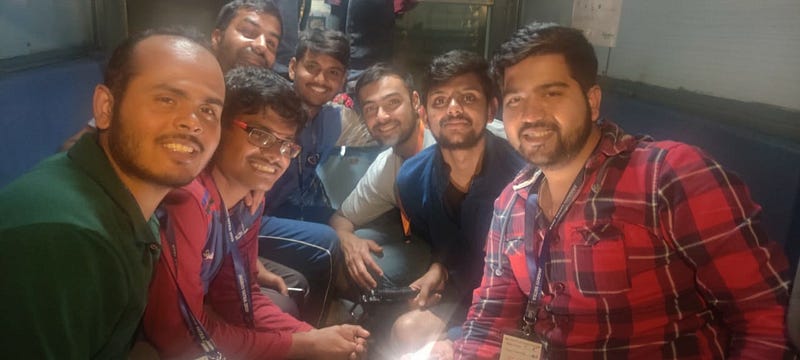
That was just my cohort in our little compartment. There was more energy exuding from compartments next to us and bogies beyond ours. And it wasn’t just the Yatris, we also had seasoned entrepreneurs, educators and thinkers from across India living on the train. They brought in a sense of sophistication and perspective that filled the rawness of the youth with colours unseen.
The nation of people on the train served my hunger to learn about India with ideas that were foreign to my foreign upbringing. They challenged my inner journey like no other, adding dimensions to my morality that only the clarity of experience can corroborate. Where else was I going to find 700 people from different parts of India from different economic backgrounds looking for purpose, looking to nation-build? Even if I did find them, how was I going to convince them to be locked in on a train for fifteen days and have conversations with me?
There was an excess of conversation potential. An excess of a potential to learn about India in a way that no book or no documentary can encompass. We were spoilt in the most wonderful of ways.
The First “Shower”
My first shower took place a couple of days in. It was a fist fight among prisoners. No, not really. But we did battle for water, buckets, mugs, permission and we were technically trapped on a train. So, yes maybe it was a passive aggressive fist fight of sorts.
Water only gets filled at certain stops, and since there are about 700 of us wrestling for it at somewhat similar times, it is a precious commodity. There are about twelve curtained compartments in a bogie upfront for about 400 men to share. You’ve got to play it smart. It needs to be a balance between how early you’re willing to get up, how cold you’re willing to feel, how long you’re willing to stand in line and when the water tanks get refilled.
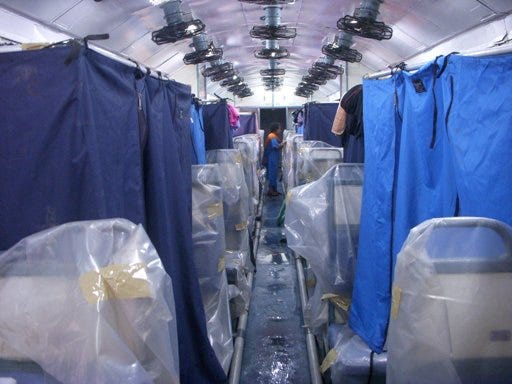
We were stuck at a station (low priority train, remember). The water was out. We were sticky and smelly after a long day out. I saw a couple of people in desperation take a bucket from the shower bogie, go to the public tap at the station, fill up their bucket and muscle their way back to steal a bath. Brilliant. I was getting a little desperate too.
I rounded up a couple of bath-hungry folks from my bogie and we looked to replicate this ingenious plan. We grabbed a bucket each and hustled towards the tap some ten bogies away. But, a twist — we were stopped by one of the organizers. I say “stopped” a little sheepishly here because apparently, we were doing something wrong. As a thirty-year-old stubborn man, I clearly didn’t like illogical restrictions. The train was at a standstill. The water was out. We were smelly. And the tap was right there. I argued (obviously, principles) but to no avail, and succumbed to an unconvincing “no is no” argument. While I was arguing for my rights, one of my accomplices sneaked across to the tap successfully, so at least someone benefited.
Upset like a little child, I huffed my way back to my bogie, contemplating schemes to sneak a bath in. Admittedly some of my schemes were probably a little too dastardly so I’ll spare you the judgment. When some sort of inner stillness was restored, we asked the bogie guard when the next water refill would be. He confided, we scheduled and then we conquered.
It was the most wondrous bucket bath I have ever had.
Never have I ever planned so extensively for a “shower”. But I also learnt that this was pretty much the norm in many hostels and parts of India. Probably with less scheming, but definitely with a lot of buckets.
A Blurring of Sorts
Our second stop was Bengaluru. They had setup a fair full of social entrepreneurs and non-profit leaders there. It was interesting but I wonder what incentive the enterprises had to be there. We weren’t looking for jobs, just for enlightenment. I’m not complaining though, it was fascinating.
We then snail-ed our way to Madurai to visit Aravind Eye Care. I was particularly excited about them because they are the epitome of a social enterprise. But we arrived horribly late, so we didn’t see any of their eye care centers, just heard some people speak. That itself was incredibly inspiring. For instance, they are currently working with Google to use machine learning to detect early onset of blindness. After their presentation, there was a panel on healthcare in India that was interesting, but I would have preferred to have been out there seeing Aravind’s world instead. And then we got stuck in Madurai at the station for way too long, because low priority, remember?
Chennai was next and we were blessed by the heavens above to get an inside glimpse of ISRO. We also spent a second in SriCity and then scrammed.
In Vizag, we got to see how Akshaya Patra delivered mid-day meals across the country. They are operational geniuses — for instance they evolved a machine that made 2,000 chapatis an hour to one that makes 60,000 chapatis an hour. 30x. Legends. But I wonder how they verify whether the meals they serve help solve hunger and malnutrition on a more permanent basis. The whole teach-a-man-how-to-fish argument.
Behrampur in Odisha was next where we visited a village amped up by Gram Vikas. Rajgir followed where we saw the peaceful Nalanda University ruins in the morning. Apparently, there were so many books in that university that the Khiljis took three months to burn it down some thousand years earlier. Post lunch, most of us took naps in the auditorium while some people spoke on stage. It was getting cold; the train wasn’t really comfortable, and we had heard enough about the vision of Jagriti Yatra and the Women Center of Excellence. A dip of sorts for sure, and the beginning of the blurring.
Deoria in Uttar Pradesh was next. We got to survey folks living in remote villages in a district that really struggles. It was probably the most insightful visit. We also did a quick build-a-business-model exercise around this where groups presented their ideas not through a PowerPoint presentation, but on chart paper instead. Unique, but you’re never going to build financial projections on a piece of paper today.
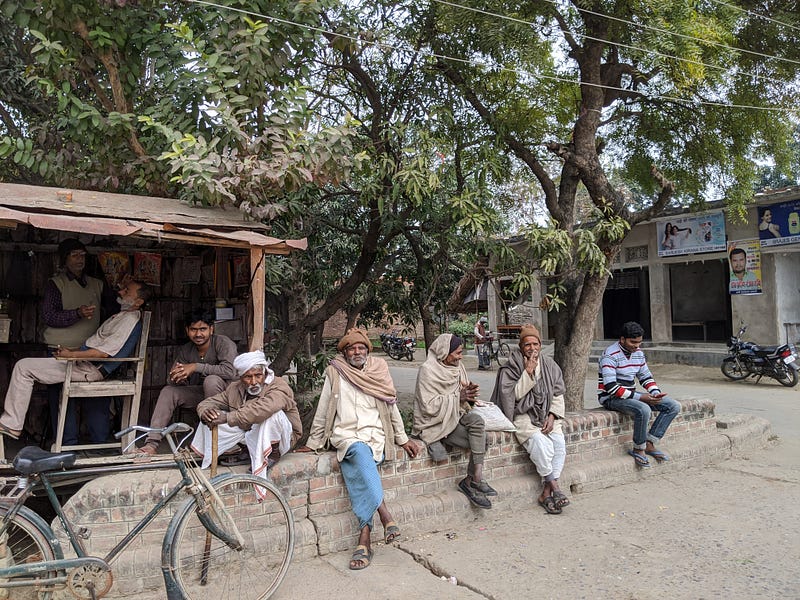
We didn’t sleep on the train that night. Instead we were squeezed into rooms in an abandoned school in Deoria. And no, nothing fancy, in fact it was worse than the trains. 15–20 of us were marshaled into rooms, many without doors, and in particularly cold weather. It seemed unnecessary but apparently the idea was to experience spending a night in a village. It didn’t all add up, but we did start appreciating the train more after.
Delhi was next, and the blurring was pretty much in full flow. I remember I had to go back to the Yatri Guide to recall where we had been, and where we had seen what. I’ll attribute that to a lack of proper sleep. Most people in the train were now coughing — a combination of cold weather and human proximity on the train I reckon. We still managed to sleep through a lot of that though. Humans adapt pretty damn quickly.
In Delhi, we met Anshu Gupta from Goonj. Goonj is doing some incredible work and Anshu is a passionate orator. He lit a fire up a lot of the Yatris who weren’t as sold on the importance of making an impact which was admirable. My fire has been lit for a while, so I was a little put off by the alarmism that Anshu employed. Effective, but not my cup of tea.
A lot of the Yatris that lived in Delhi took this opportunity to sneak out and get a proper shower in. This was controversial because this wasn’t technically allowed. Discipline oh discipline.
Discipline
An important tenet of the Yatra is discipline. Transporting 450 participants in a train at breakneck speed is not easy. Rules and discipline are key. Makes sense. One of the rules is that you’re not allowed to leave the train or any of the premises that we visit. Makes sense.
But maybe, a gross interpretation of this rule begs a debate? For instance, I was not allowed to go get a coffee from a canteen that was 20 meters away and within the premises of where we were. As a thirty-year old adult, this really rubbed me the wrong way. I obviously didn’t listen because principles. But then I was threatened of being deboarded off the train. And I was also asked to write a formal letter of apology. I did laugh out loud at this (and obviously didn’t write the letter), which really didn’t help my case. Yes, at one point, I was guilty of being rude. I owned up to that and apologized for it. But principally, I did feel this was a bit ridiculous. Versions of this happened to me more than once, and I wasn’t the only one. At least I was willing to put up a fight, most just sneaked out instead.
This obviously led to a lot of internal debate which I externalized pretty quickly. The other side of the debate is that exceptions are costly, so a strict implementation of the rules is important. Easing the rules or allowing exceptions leads to a bad precedence, and chaos could ensue. Fundamentally, I agree with this.
Where I was stumped was with the target demography. The 450 participants averaged to around 25 years of age, and were selected from over 2,500 applicants, and were touted to be a representation of the best of India. The question that I struggled with was that if these are the best young adults of India, can they not be trusted to take a few minutes out to go get a coffee? Can they not be trusted to make a quick visit home to take a shower while they are in the vicinity? Is that too much to ask?
I did ask these questions to other people on the train. And this is where it gets complicated. The Yatra takes responsibility for people on the train. One bad apple does spoil the bunch and could have a terrible impact on the reputation of the Yatra. Also, people from different backgrounds have different levels of freedom. For instance, younger women from more traditional homes only barely get permission to go out on a fifteen-day journey by themselves. Freedom could be a different concept for them. Their parents could be a lot more particular about how strict the rules at the Yatra are.
But then the alarm that go off in my head is are we solving for exceptions? Is that even pertinent, especially when people are sneaking out anyway? And this, quite dramatically, leads me to think about the general impact of paternalism in India. Does excessive amount of paternalism come in the way of maturity? Does it delay it? Does it encourage rebellion?
The answer as always lies somewhere in the middle. I think with the Yatra, a middle ground could be that if someone wants to leave for a few, they must fill a quick liability release form. This lifts the burden off the organizers and puts some physical toll on the participant, while maintaining the illusion of freedom. But yes, rules are important, and their strict implementation is needed to avoid chaos.
Also, it was interesting to see how the 65 facilitators broadly auto divided themselves into two different camps of thought around this. One side seemed more pro-independence and the other side more pro-rules. Less control versus more control. Bear the discomfort versus fix the discomfort. I skewed more towards the “less-control” folks, but my upbringing isn’t necessarily the norm.
I need to read up more on the more existential question of the impact of excessive paternalism on maturity. The key word here is excessive. A balance is what always seems to be the answer — just the right amount of paternalism, maybe? What’s the “right” amount though? Haha now we tread on realms of infinite regress.
The Bunker
After Delhi, Tiloniya in Rajasthan was next. That’s where Barefoot College was born along with the legend of Bunker Roy. After walking around the solar-powered campus, we were treated to a session with the legend himself.
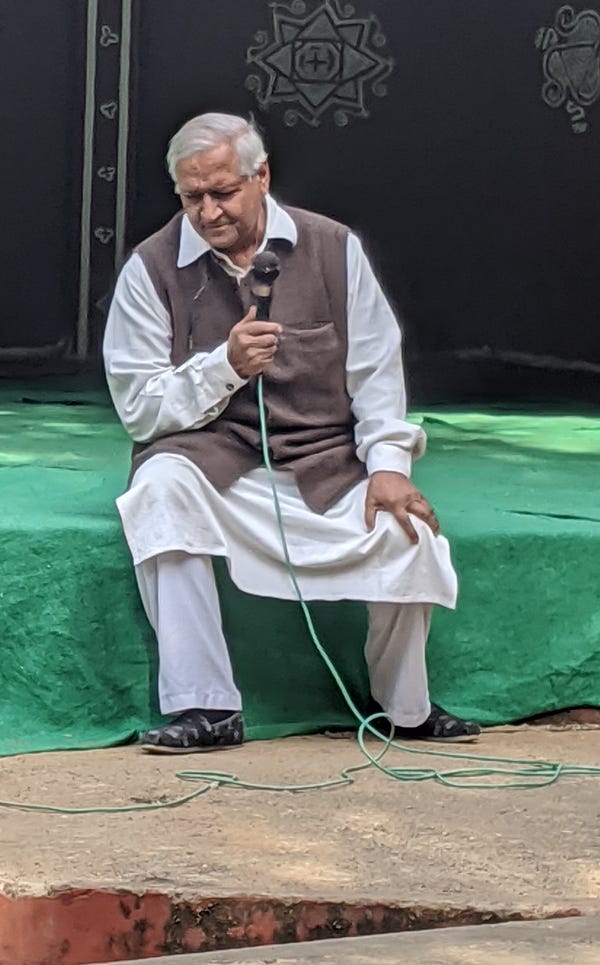
Bunker Roy appeared, sat down on stage and threw the floor open for questions. It was all a little mystical in the most wondrous of ways, and this is coming from someone who doesn’t believe in magic. He championed a level of depth that only comes from having skin in the game. Some real deep skin in the game. The wisdom flew off his tongue as easily as his demeanour. As gently as his voice. As compellingly as his presence.
Start small, he said. Do more and study less, he said. Be where there needs to be work done, not locked away in an office in some skyscraper, he said. All the while he embodied the aura that natural leaders exude — an aura not restricted by norms, but instead empowered by the confidence to reshape them. There was a sense of authenticity that no one can pretend to put on. This was him through and through. He had already walked his talk.
And I sat there, a little teary eyed, yearning to be a version of him.
At Peace
Ahmedabad was our last stop. There was an element of lethargy in the air. We were a lot more comfortable with each other and the conversations were a little less exciting. I was looking forward to a nice hot shower and a warm bed free from vibrations that was larger than six feet by three feet.
The rules became a little lax. There would be no roll call in the train that night. A little less than half the participants were going home after the graduation ceremony. Don’t know what we were graduating from, but there was a formal closing ceremony later on that was nice.
We were at the Gandhi Ashram, sitting at the edge of the Sabarmati river. I felt at peace. Familiar faces all around. Photos being taken out of a desperation to preserve the current bliss. Conversations getting personal and more relaxed. Silence becoming comfortable. It was as if all the ingredients were in place for a perfect reflection.
I came to the Yatra with two distinct goals. One was to get to know India a little better and the other — more personal, more daunting — was to see if I could fit in as an Indian among Indians. I hadn’t lived in India in over twenty years. Yes, I visited regularly, but I was defined by a different set of borders of which the Indian subcontinent was just a subset. I was someone who has been everywhere but is from nowhere, and all of a sudden, I was craving belonging.
I did get to know India better, but it wasn’t by visiting the different places, it was mainly by the people on the train. People who came from all parts of India, from all types of religions, with different languages and different economic backgrounds, and from the conversations we shared. There was common ground to be found in reason, in purpose, but it stemmed from varying perspectives and contexts.
I got exposed to a different form of thinking. A form of thinking that forms the bedrock of Indian culture which is often marred by convenient interpretations. But that doesn’t mean that the Vedic life is inapplicable today.
I embraced my Indianness more than ever. For once, eating your heart out with your hands and licking your fingers after was the norm. It didn’t matter that many of us got our Vs and Ws mixed up when we enunciated, we still understood each other. Claps were doled out like currency, a worthy cheap form of positive expression. And we Indians love acronyms way too much — wouldn’t mind if that changed.
I also learnt that reaching a conclusion after every argument is not always necessary. Sometimes it is the depth of discussion that matters more, the nuances. There was a panel on women empowerment which when asked about discrimination against women, said that they were not discriminated against — in fact, as women entrepreneurs, they felt they had a slight advantage.
Then there is the other side to the women rights movement where certain laws treat women differently than men in India. For instance, a man can serve up to three years in jail if he gets convicted for sexual harassment but there is no such explicit law made for women. There’s obviously good reason for this, but it also does portray an unneeded disparity. Someone in my cohort bought this up — “I don’t sexually harass women but why are they protected by law and I’m not? Equality goes both ways.”
There was also the voodoo topic of sexuality and sex. There is no proper sex education in India, and sex is considered such a precious, restricted and sacred commodity. I can’t help but think how sexual repression correlates to abuse. It’s not an excuse, but it could be a factor.
I got on the train while the country was in the middle of extensive CAA protests. I was expecting intense amounts of passion on the train around this, but it was a lot calmer than I expected. There seemed to be both anti and pro sentiments, but none with the amount of gusto I see on social media or among people who identify as Indians but who live outside of India. Either it was fear that censored their passion, or it just wasn’t as important to the folks as it seemed from the outside. I think it’s the latter.
I know I live in a privileged, left-wing bubble, and this experience further cemented that as true. Problems and priorities are different for people with different privileges. And when you’re still taking bucket baths or practicing open defecation, a law that directly impacts 0.003% of the population might not matter as much.
The people I got closest to on the Yatra called me ‘Angrez’ (“English”). That was almost like a violent attack on a deep-rooted insecurity around my Indian-ness, but it turned out to be a term of endearment. I blended in soon enough, leveraging humility and humour to find common ground, and accepted what needed to be accepted — I am different. Just like everyone else is in their own way. So obvious. So simple. So cliched.
I don’t think I would do this a second time, but the first time was well worth it. It pushed me in all directions, from discomfort to comfort. From embarrassingly broken Hindi to my supposedly intellectual English. From uneasy living to easy conversations. From zero to hero to zero. It was a friggin’ incredible roller coaster. And the best part about it was that there was no real safety belt.
